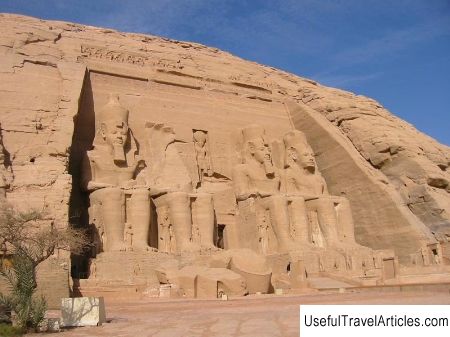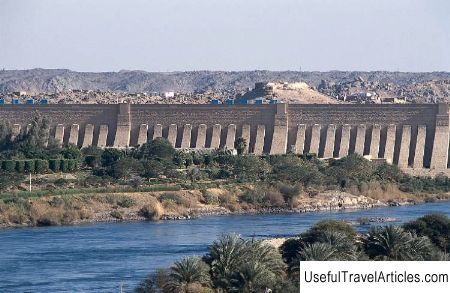Abu Simbel description and photos - Egypt: Aswan
Rating: 8,3/10 (798 votes) 
Abu Simbel description and photos - Egypt: Aswan. Detailed information about the attraction. Description, photographs and a map showing the nearest significant objects. The title in English is Abu Simbel. Photo & DescriptionThe Abu Simbel Temples are two massive rock-cut shrines in Nubia, southern Egypt, near the border with Sudan. They are located on the shores of Lake Nasser, about 300 km along the road southwest of Aswan. The twin temples were originally carved into the rock during the reign of Pharaoh Ramses II in the 13th century BC as a monument to the ruler and his wife Nefertari in honor of the victory at the Battle of Kadesh. Their huge relief figures on the outside have gained worldwide fame. Construction of the temple complex began around 1264 BC. and lasted for about 20 years. Known as the Temple of Ramesses, Favorite of Amun, it was one of six similar stone structures erected in Nubia during the long reign of that pharaoh. Over time, the buildings fell into decay and were covered with sand. Already in the 6th century BC, sand covered the statues of the main temple to the knees. The re-opening of the architectural monuments took place in 1813, when the Swiss orientalist Jean-Louis Burckhardt found the upper frieze of the main temple, but did not get inside ... In 1817, Giovanni Belzoni was able to enter the complex, a little later the first detailed description of the temples and pencil sketches were made. The complex consists of two temples. The more spacious one is dedicated to Ra, Ptah and Amon - the three main deities of Egypt; its facade is decorated with four large (20 m) statues of Ramses. The smaller room is the temple of the goddess Hathor, who personifies Nefertari, the most beloved of the many wives of the pharaoh. Colossal figures of a king sitting on a throne in a double crown of Upper and Lower Egypt, were carved right into the rock. The upper part is crowned with a frieze. The statue to the left of the entrance was damaged by an earthquake, the lower part survived, and the head and torso can be seen at the feet of the monument. There are other statues nearby, they are not higher than the knees of the pharaoh. The figures depict Nefertari, the queen mother of Tui, his first two sons and first six daughters. The entrance is crowned with a bas-relief representing two images of the king bowing his head in front of the sculpture of the falcon Ra in a large niche. A distinctive feature of the facade is the stele, which depicts the marriage of Ramses with the daughter of King Hattusili III as a confirmation of peace between Egypt and the Hittites. The inner part of the sanctuary is a classic triangular shape, characteristic of the most ancient Egyptian religious buildings, with numerous side cameras. The hypostyle hall measuring 18 by 16.7 meters is supported by eight huge columns-statues of Osiris, the god of the underworld. The figures along the left wall wear the white crown of Upper Egypt, the statues on the opposite side wear the double crown of Upper and Lower Egypt. The bas-reliefs on the walls of the hall depict battle scenes of various military campaigns. The hypostyle hall passes into a second room with columns decorated with scenes of offerings to the gods. This room leads to the sanctuary, in which four seated figures are carved from stone on a black wall: Ra, the deified Ramses, the gods Amon Ra and Ptah. It is believed that the axis of the temple was positioned so that on October 22 and February 22 the sun's rays penetrated into the sanctuary and illuminated the sculptures on the back wall, except for Ptah, the god of the underworld. Hathor Sanctuary and Nefertari, or Small Temple, was built about a hundred meters northeast of the temple of Pharaoh Ramses. This is the second temple in the history of ancient Egypt dedicated to the ruler. The rocky facade is decorated with two groups of colossi, which are separated from each other by a large arch. The statues, just over ten meters high, depict the pharaoh and his wife. On both sides of the portal there are two sculptures of the ruler surrounded by the gods Set and Horus, small figures of princes and princesses. The interior of the Small Temple is a simplified version of the Great Temple. The bas-reliefs on the side walls of the stone sanctuary represent scenes of offerings to various gods from the pharaoh or queen. Each temple was served by a separate priest who represented the pharaoh in daily religious ceremonies. The complex was relocated in full in 1968 to an artificial hill above the Aswan Dam reservoir. The relocation of the temples was done to prevent flooding during the creation of Lake Nasser, a massive artificial reservoir formed after the construction of the Aswan Dam on the Nile River.        We also recommend reading Palace of the Bishops of Krakow (Palac Biskupow Krakowskich) description and photos - Poland: Kielce Topic: Abu Simbel description and photos - Egypt: Aswan. |




